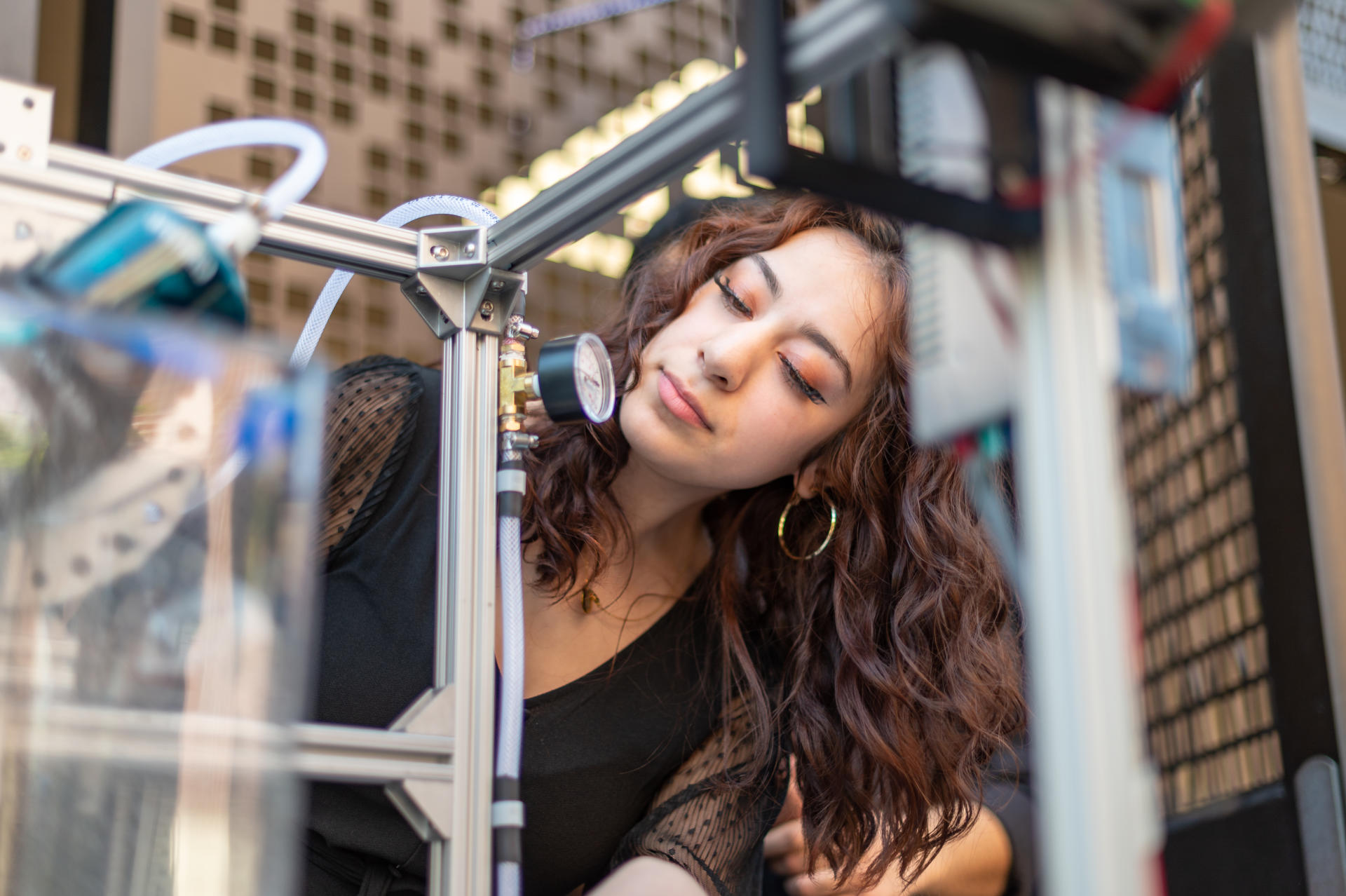Engineering Success: Students Solve Real-World Problems

From self-cleaning pool robots to a self-stabilizing spoon for Parkinson’s patients, students from the College of Engineering, Computer Science, and Construction Management (ECC) showcased their skills, flair for innovation, and the high-quality education they acquired at Chico State to complete their capstone projects.
Students presented their work at the ECC Senior Design Capstone Project Expo, the culmination of a year of hard work and of their time at Chico State, on May 12. More than 150 projects were on display.
Capstone projects let students take what they have learned and apply it to real-world problems, said ECC Associate Dean David Alexander. All the programs in the college are hands-on and project based. From their first year, students are working in teams to build, make, or create something, and that leads up to their capstone.
For some ECC programs, students also work with industry partner sponsors. Companies spend two semesters working with students, who present ingenious solutions to their problems, and in turn, students learn how to work with customers.
“It’s an amazing program,” Alexander said. “It’s incredible to see students transform from students to professionals. They are beaming and are so excited to tell you about their project, which they’ve poured their heart and soul into.”
Here are four of the projects on display on Friday.
Smart Pool Sweeper
Students: Jarrel Cook, Yaroslav Dovbnenko, Max Famini, and Oscar Rodriguez
Faculty advisor: Charles Pooler
Sponsor: Raypak—Ryan Valencia ’18
Jarrel Cook, a mechatronic engineer major, and his teammates Yaroslav Dovbnenko, Max Famini, and Oscar Rodriguez, all mechanical engineer majors, were sponsored by Raypak, which specializes in designing and manufacturing heating and hot water solutions. Raypak challenged them to build a prototype of a cleaning robot that can enter and exit a pool on its own, as well as map out specific features of the pool, Cook said.
The group spent close to 2,000 hours on the project over nine months.
“There’s been so much time dedicated to this,” Famini said. “We, as a team, are very proud of what we have to show for it. We’re all glad we have something working and effective that we can show off—this is our baby.”
Aside from the technical and practical skills developed through capstone, Dovbnenko said students learn to work as teams, to communicate, and time and project management.
Self-Correcting Spoon
Student: Justin Crane
Faculty advisor: Zahrasadat Alavi
Inspired by his grandfather, Justin Crane created a self-correcting spoon for individuals who have internal tremors, like those seen in people with Parkinson’s, and have a difficult time eating with a spoon.
Using two servo motors, a microcontroller, a gyroscopic sensor, and an AA battery pack system, the spoon’s system counteracts involuntary motions to remain level and allows the user to enjoy certain solids and thicker liquids.
Crane’s spoon was in its third iteration, as he had to do a lot of troubleshooting to get it to work.
“My professors helped a great deal to solve problems,” said the electrical engineering major. “I was also able to use prior knowledge from classes, as well as the research they provided, to finally come out with a working project.”
Flow Test Stand
Students: Ahman Ali, Davy Capriles, Kyle DiBiasio, and Melania Raygoza
Faculty advisor: Harold Koehler
Sponsor: CamelBak
Mechanical engineering major Davy Capriles and his group were tasked by the outdoor equipment company, CamelBak, to develop a machine to test the flow rate of water coming out of different nozzles and bite valves attached to water bottles and hydration packs.
Having this information is important as the company develops products, Capriles said. An average person can only suck with about 1.5 PSI of pressure. He explained that they wanted to measure the flow in one minute to ensure an adequate amount of water was flowing out at that pressure, but not have such little resistance that there is a leak.
CamelBak shared that their current test stand needed to be more efficient, Capriles said. It takes 10 liters of water and 30 minutes to get going for every single bottle or pack.
“They can’t use it because of how difficult it is,” he said.
The group dedicated over 1,000 hours to their project with planning and designing happening in the fall and building the prototype this spring.
“Every class for the last five years has talked about this day,” Capriles said. “So, to be here with a working product, it feels great.”
Magic Charger
Student: Mohammed Alsubousi
Faculty advisor: Ghang-Ho Lee
Mohammed Alsubousi has been so fascinated by wireless charging technology for the past 10 years that he chose to major in electrical/electronic engineering so he could build something himself.
The project for his capstone gave him a hands-on opportunity to create his first device. His “Magic charger” is a wireless charger that uses two separate circuits—one transmitting and one receiving—to power various devices, such as phones and smartwatches. The overall purpose of the project is to create a better understanding of how power can be sent and received wirelessly, he said.
Wireless charging technology is advancing fast, Alsubousi explained. Companies are currently trying induction charging for vehicles, which would make it possible for cars to charge without a cable or a special socket.
“I want to be a contributor to advancement in this project,” he said. “But first, I had to understand the theory behind the wireless charging—where and how it’s transmitting, how it’s receiving, and how is everything behaving.”
Alsubousi said there were many sleepless nights researching, building, and reassembling after circuits burn, but it’s all part of the process.
“I had to redo everything over and over again for weeks until I got it to work,” he said. “But once I got it to work, it was the best feeling ever.”


